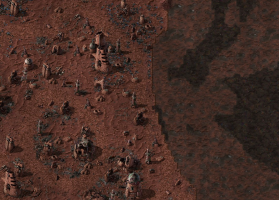Fulgora
| This article is a stub, and not comprehensive. |
|---|
| You can help this wiki by expanding it. |
![]() Space Age expansion exclusive feature.
Space Age expansion exclusive feature.

Fulgora is a new barren desert planet. Its surface is split between island-like plateaus, and deep oilsands. During the night, the planet is ravaged by lightning storms, damaging buildings.
Mechanics
Terrain
Fulgoran terrain is mainly composed of oillands, on which nothing except for rail supports can be built. Traversal by foot across the oillands is possible, but slow. The oillands are further divided into deep and shallow areas, with deep areas slowing down player movement even further and not even allowing for rail supports to be built without research.
However, the oillands are also scattered with islands of various sizes, on which normal construction is possible. At first, these are the only place on Fulgora where factories can be built, as foundation for building on top of the oillands requires research that can not be performed until much later.
The islands come in three size classes:
- Small islands with high amounts of resources, but with little room to build on
- Medium islands with lower amounts of resources, and with sufficient room for a small factory
- Large islands with no resources, but with enough room to build the main part of a medium-sized factory
It is possible for two or more islands to overlap, potentially creating an even larger island that does have local resources. However, most islands are detached, meaning that transport between islands will have to occur by train. In many cases, the distance between two islands is also too vast for roboports or big electric poles to reach, thus requiring local logistic and electric networks to be built, as neither roboports nor power poles can be built on the oillands without foundation.
Biomes
Fulgora is split between two distinct biomes.
- Plateaus are islands dotted around the landscape. They are the only biome where factories can be built. Some plateaus are home to alien ruins, which have rudimentary lightning rods, which can protect your buildings until unlocking your own lightning rods. Other plateaus hold scrap
 , Fulgora's sole resource.
, Fulgora's sole resource. - Oilsands are the lowlands between the plateaus. No buildings can be built in them except for rail supports
 . You can walk through them, but occasional oilpatches will slow you to a crawl. An offshore pump can be placed on the edge of oilsands to produce an unlimited amount of heavy oil.
. You can walk through them, but occasional oilpatches will slow you to a crawl. An offshore pump can be placed on the edge of oilsands to produce an unlimited amount of heavy oil.
Lightning
During nighttime, dense thunderstorms occur on Fulgora, with frequent lightning strikes occurring across the surface.
If a lightning strike is set to occur near a lightning rod, lightning collector, or certain kinds of ancient ruin, then the lightning will always hit said entity, rendering the lightning harmless. However, if such an entity can not be found, the lightning will strike where it occurs, causing damage to nearby entities.
When a lightning rod or a lightning collector is struck by lightning, it will generate a brief but powerful burst of electric energy, which can be utilized by connecting it to the electric network. With enough accumulators to last during daytime or between lightning strikes, this can serve as the factory's main power source.
With this, lightning on Fulgora become both a curse and a blessing: Players must keep their factory covered by lightning rods or collectors to avoid damage, and nighttime exploration becomes dangerous and risky. However, to an established base, lightning become a convenient source of electric energy, which is especially important given the weak solar output on Fulgora's surface and the difficulty of setting up a global electric network on Fulgora before foundation becomes available.
Exclusive Items
The following items are unlocked on Fulgora:
- Electromagnetic science pack

- Electromagnetic plant

- Lightning collector

- Lightning rod

- Recycler

- Tesla turret

Gallery
-
Example landscape of Fulgora.
